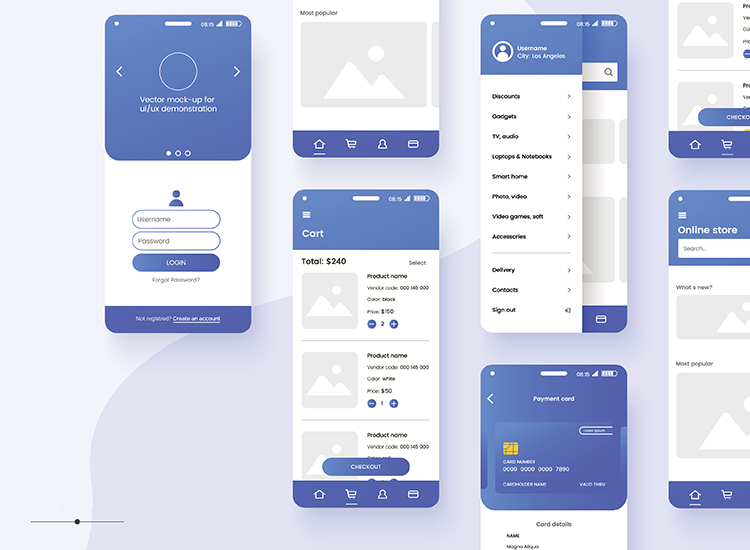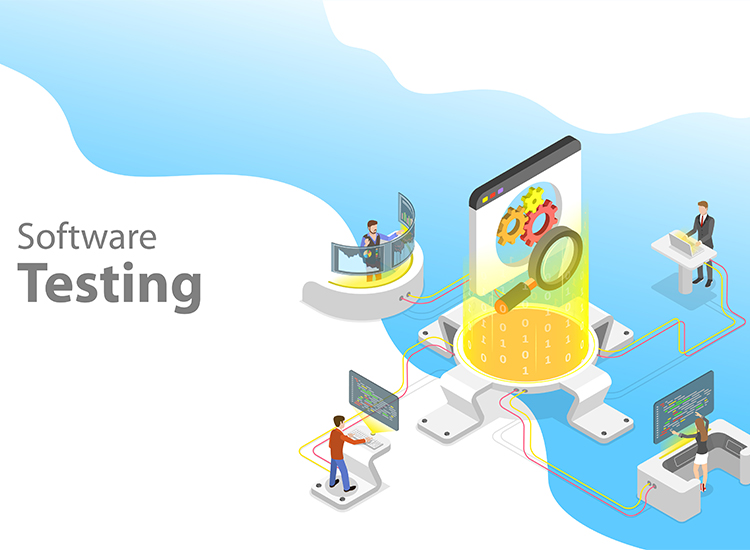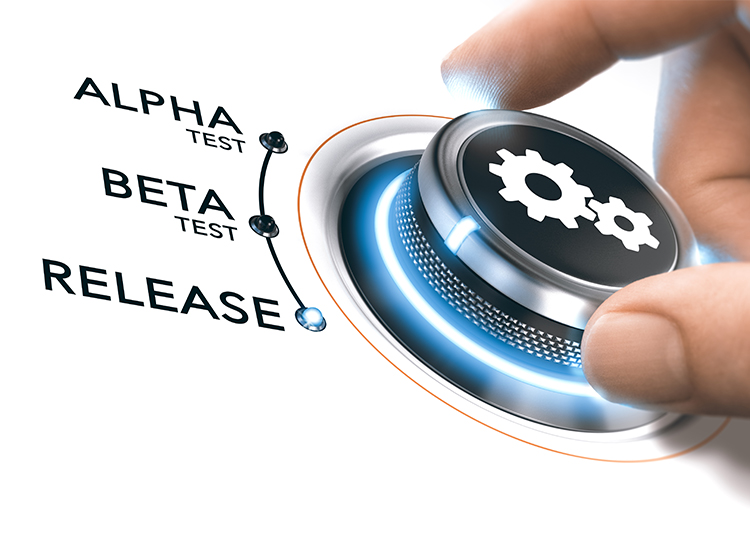Mobile Application Development
Mobile applications are a significant part of our daily life. Thanks to substantial mobile app development, there are apps for practically anything, including retail, travel, health, gaming, and entertainment.
There are many platforms available for developing smartphone applications; one should select a platform after carefully taking into account a number of important factors, including the cost of development, the targeted audience, current technologies, the business model, and the time required to develop. Our experienced team is available to provide thorough guidance while helping you design an effective app development process that meets your needs.

Numerous business-related apps are also available, addressing topics like productivity, planning, and communication.Many of them are "generic" apps made by well-known experts in their industries, such as the search engine giant Google, but some commercial mobile apps are made by specialized mobile app development companies for particular businesses and organizations.
Even though the use of mobile applications is constantly expanding, there are some factors to take into account before making the leap and hiring the right professionals to develop the applications.We strongly believe that the business and app development teams should work together as one team in order to achieve the best results. That requires Our staff, who is here to assist you at every stage in making your concept a reality.
Our Work Process
1

Research and planning
The planning stage is a very important one in the development of an app because it needs to take place immediately after the conception of the app.
Typically, the planning and research phase entails a thorough feasibility analysis and substantial market research. This stage ultimately determines whether there is a market for and the likelihood of success of your app idea.
Questions like "Are there similar Applications currently on the market?" and "How soon can we have MVP - 'Minimum Viable Product' ready to launch in the market?" arise during this phase. In addition, questions like "What's our Middle Term "1 Year" and Long Term "3-5 Years Vision for this Application?" also arise.
Determining the platforms, such as iOS, Android, Web, etc., on which you want your applications to run is also crucial. Whether you choose to use a hybrid method to design the application for several platforms or to develop natively for each platform, we are here to support you.
2

Prototype
We will "build an interactive mockup" of a mobile application during the prototyping stage. A prototype is an interactive but not yet functioning version of the future application that is relevant to the development of mobile software. Pre-development stage prototyping entails simulating the app's user interface design without actually writing any code. The most significant advantage of mobile app prototypes is early testing of an app concept to determine its user appeal.
Wireframes will be produced quickly during this stage while iterating on client and user feedback.A wireframe provides a low-fidelity, high-level overview of the UI, UX, and structure of your app while avoiding the need to focus on minute aspects like color and style. It also provides a basic understanding of the app's essential features and functionality.
Furthermore, prototyping improves the clarity of your initial vision, assisting investors as well as developers in fully realizing the concept of a future mobile application. Also, it enables getting thorough customer input prior to the start of development, which will eventually prove to be a priceless source of information for both commercial and technical teams. Additionally, it has a lot greater potential to attract investors at a low cost. Potential investors find interactive prototypes of apps to be more appealing and understandable than drawn flowcharts and sketches.
This stage of app development is crucial since it will enable us to confirm whether the app you are creating will in fact satisfy the needs of your target market. It is time to move on to the design phase after revising the feedback you have obtained from your audience and making sure that they are favorably responding to your prototype. According to statistics, 68% of mobile apps are removed by users after they give it a try. By creating a mobile application prototype, you may boost the likelihood that your software will remain on users' devices.
3

Design
We'll quickly go through some of the most significant ones in the design stage of an application. The approved wire frames will need to be refined, first and foremost, by UI and UX designers.
A UX designer typically develops wireframes as a guide for graphic designers to add the graphic elements.
Compared to the wireframes produced during the prototyping process, these will be significantly more detailed and include a greater number of screens.
In the Design phase In order for your app's branding to be recognizable and well-understood by both your designers and developers, you must also build a brand guideline. It's crucial that every screen adhere to your rules if you want to create a unified app. During this phase, developing a marketing plan should also happen concurrently. Typically, this entails planning a complete marketing budget and distributing funds appropriately. The implementation of a search engine optimization strategy, Run sponsored marketing in app stores, run app store optimization strategies, buy search advertisements. Use influencer marketing, social media marketing, content marketing plans, etc.
4

Development
You really start writing the code for the "ultimate" version of the program during the development phase.
It is possible to use approaches like Waterfall, Lean Startup, Spiral, or Agile at this phase. An Agile implementation is highly preferred in the current app development process because it allows for iterations, which greatly reduces errors and mistakes that are frequently made.The approach also aids in dividing the project into a number of short time boxes or development cycles that are given to each member of the project team. It is a collaborative strategy that enables a reaction to quick change. The mobile app is adaptable enough to take into account changes in project needs.
5

Testing
Testing should ideally take place concurrently with the development phase.
Because it is essential to regularly test in order to keep post-release expenditures low. The development of an application must include unit tests, UI tests, and integration testing.
A longer cycle that includes research, process flow design, technical documentation creation, thorough testing, debugging, and iteratively bringing an application to live is the testing phase. Pre-deployment testing looks for underlying faults and problems to prevent them from entering production. In comparison to later stages of software development, fixing issues early on is less expensive.
Pre-deployment testing looks for underlying faults and problems to prevent them from entering production. The pre-deployment testing procedure includes performing end-to-end testing, confirming testing, and manually verifying features and functionalities.
Additionally, testing will be very beneficial later on in any application's maintenance and support phase.
6

Deployment
When your native app is ready, you should submit it to the relevant app store, such as Google Play for Android apps or the Apple App Store for iOS apps. Before releasing your mobile app, you must have a developer account with the Apple App Store and Google Play Store.
Understanding this procedure is essential because we'll have to use it each time you release a new version of the application. In order to make a software system accessible to the intended audience, practical actions and measures must also be taken. It is a highly important step since mobile app launches are one of the most important parts of the development process because they allow developers to distribute apps, fixes, updates, and modules to their user bases.
7

Maintenance
The maintenance phase should move forward concurrently with deployment and really starts at the same time. The ongoing updating, analyzing, altering, and re-evaluation of your current software applications is known as application maintenance.
Application maintenance, as the name suggests, entails caring for any application after its development. The continuous upgrading, changing, and re-evaluation of software applications to fix bugs or boost performance is known as application maintenance.
Additionally, our staff is available at all times to offer application support and maintenance services. They are designed to make sure that all kinds of apps are very accessible, trustworthy, and pertinent to your ever-changing business needs.

